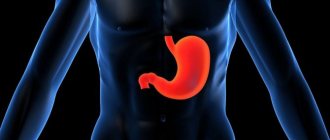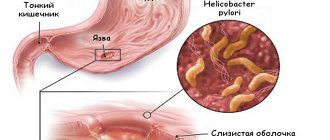Malignant tumors of the spleen are very rare. They can be primary (when the tumor initially develops in the spleen) or metastatic (when tumor cells from other organs spread to the spleen).
- Causes of development and risk groups
- Classification, stages
- Symptoms of spleen cancer
- Metastases in spleen cancer
- Diagnostic methods
- Treatment of spleen cancer
- Complications
- Recurrence of cancer
- Survival prognosis
- Prevention
Causes of development and risk groups
Malignant tumors develop as a result of mutations that occur in cells. These mutations affect genes that regulate cell reproduction, apoptosis (programmed cell death), and repair of damaged DNA. It is difficult to say why such mutations occurred in each specific case.
Some conditions increase your chance of developing cancer—they are called risk factors. If we talk about the most common type of spleen cancer - lymphoma, then the risk factors will be as follows:
- Age. Over the years, mutations accumulate in the cells of the human body and the likelihood of developing various types of cancer increases.
- Floor. Men get sick more often.
- Family history: if lymphoma has been diagnosed in close relatives.
- Immune system disorders: weakened immunity, autoimmune diseases.
- Exposure to the body of certain harmful substances.
- Some studies have found a link between chronic hepatitis C and B-cell non-Hodgkin lymphoma.
Classification, stages
“Spleen cancer” is not quite the correct term. Strictly speaking, cancer refers to tumors that originate from epithelial tissue. In the spleen, malignant neoplasms develop from other types of tissue. Their classifications have changed over time and differ among different authors. Currently, doctors are often guided by the L. Morgenstern classification, developed in 1985. In accordance with it, all malignant tumors of the organ are divided into three large groups: vascular, lymphoid and non-lymphoid:
| Examples of vascular tumors |
|
| Examples of lymphoid tumors |
|
| Examples of non-lymphoid tumors |
|
Lymphomas most often occur in the spleen. However, primary organ damage is a rare occurrence. It is known that in non-Hodgkin's lymphoma the spleen is involved in 50–80% of cases, and this often occurs in Hodgkin's disease.
The most common vascular malignant tumor in the spleen is angiosarcoma. However, it is a very rare disease - it affects 1-3 people in ten million. Angiosarcoma originates from the tissues of the vascular wall, is highly aggressive, and quickly metastasizes.
Book a consultation 24 hours a day
+7+7+78
Symptoms of spleen cancer
Diagnosing spleen cancer based on symptoms is very difficult. Manifestations of the disease are nonspecific; they can occur in many pathologies, including other types of cancer. With lymphomas, 25% of patients have no complaints at all, and the tumor is diagnosed by chance.
Main symptoms:
- pain in the abdomen, usually in the upper left part;
- weakness, increased fatigue;
- weight loss for no apparent reason;
- increased body temperature;
- night sweats;
- enlarged subcutaneous lymph nodes: in the axillary and groin areas, on the neck;
- increased bleeding, which manifests itself in the form of bruises on the skin;
- decreased appetite;
- frequent infections.
It is important to pay attention to any unusual symptoms. If they persist for several days, you should consult a doctor. This helps to diagnose cancer and other diseases in a timely manner.
Location and functions
The spleen is an unpaired oval organ. Its location is the upper left part of the abdominal cavity, behind the stomach, next to the diaphragm and pancreas.
The functions of the spleen are very important:
- During intrauterine development, the spleen is engaged in the production of blood ; by the time the child is born, the bone marrow is already fully formed and begins to produce red and white blood cells.
- There are blood diseases in which areas involved in hematopoiesis appear in the spleen.
- The spleen stores a third of all platelets in the human body. And if for some reason there is a large loss of blood, then the supply of platelets from this storage enters the circulatory system.
- The most important function of the spleen is lymphopoiesis . It is this organ that produces the largest number of lymphocytes that circulate through the circulatory system.
- In addition, the spleen is involved in blood purification. It acts as a kind of filter, the task of which is to trap harmful bacteria. It produces antibodies. Immunoglobulin synthesis is impossible without her participation. Thus, this organ performs an important immune function.
People with their spleens removed are more susceptible to bacterial infections than others.
Watch a video about the purpose and diseases of the spleen:
Diagnostic methods
With malignant neoplasms, an enlargement of the spleen is often observed. It can be detected during ultrasound, computed tomography, and magnetic resonance imaging. However, if the spleen is enlarged, this does not mean that a person has cancer. It may be a benign neoplasm.
If an enlarged spleen is detected, the doctor may prescribe a complete blood test and a red bone marrow test. The most accurate method for diagnosing a malignant tumor is a biopsy. Material for histological and cytological analysis can be obtained by puncture (using a hollow needle) or by removing the spleen.
Is it possible to diagnose spleen cancer in the early stages, before the first symptoms appear? There are no specific screening tests. There are no studies that can be recommended for all people to undergo regularly. People who have certain risk factors should pay increased attention to their health: viral hepatitis B and C, immunodeficiency conditions, autoimmune pathologies, treatment with immunosuppressants. If you begin to worry about the symptoms listed in this article, you need to visit a doctor and get checked.
Causes of pain in the spleen
Soreness is one of the symptoms of spleen diseases
There are quite a few diseases associated with the spleen. And that is why there are also many reasons for the occurrence of such pain. But the main ones include:
- Parasites. Very often, eggs of one or another parasite enter the human body, which over time find a place in the organs and begin to multiply. But to this is added the fact that most parasites have strong jaws, with the help of which they pinch off pieces of organ tissue, thereby worsening the general condition of a person and provoking the development of ailments
- Tumors that can be either benign or malignant. Unfortunately, tumors do not immediately begin to manifest themselves, and only after a biopsy can we tell what type of tumor a person has
- Injury to the spleen, which can be closed or open. Often, injury to this organ can occur during a fall, as well as during an impact.
- Problems with blood vessels, impaired blood supply
- The formation of cysts that prevent the organ from functioning normally
It is not always possible for a person, as well as a doctor, to accurately name the true cause of the development of spleen disease, since many additional factors are added to the main factor, which makes accurate diagnosis difficult.
Treatment of spleen cancer
Treatment approaches depend on the type and stage of the malignant tumor. For example, with lymphomas, if there are no symptoms, it is enough to go to the doctor for examinations and take blood tests every six months. If, for example, a metastasis of a solid tumor is detected in the spleen, active treatment is required. Below we will consider the basic principles of treatment of lymphomas as the most common tumors of the spleen.
Surgical interventions
The main type of treatment for splenic lymphoma is organ removal, splenectomy. Statistics show that most patients who undergo such surgery do not require any other types of treatment over the next five years.
Chemotherapy
In some cases, chemotherapy is used - drugs that destroy tumor cells. Some are administered intravenously, others are taken in tablet form. The type, dosage and schedule of administration of chemotherapy drugs are selected depending on the type and stage of the tumor.
Studies have shown that rituximab, a drug from the group of monoclonal antibodies, can be an effective alternative to splenectomy for lymphomas. It helps to get rid of symptoms and avoid complex surgery.
Radiation therapy
In some cases, radiation therapy is used to combat lymphomas. X-rays and proton therapy are used.
Radiation therapy is used as an independent type of treatment to combat tumors in the early stages. In later stages and with aggressive tumors, it is combined with chemotherapy. In addition, radiation helps combat symptoms caused by metastases.
Stem cell transplant
Stem cell transplantation (red bone marrow transplantation) is indicated in cases where the tumor cannot be treated with chemotherapy and radiation therapy. High doses of chemotherapy or radiation are given to suppress the patient's own red bone marrow, and then red bone marrow stem cells, either their own or a donor's, are injected into the patient's blood.
How to treat the spleen
When it is no longer possible to cope with the painful syndrome, it is necessary to use a drug that will soothe the pain. It is necessary to normalize breathing. You should not use various heating pads, this will only worsen the patient's condition. The first step is to call a doctor so that he can make the correct diagnosis.
The treatment process may vary. Some people resort to using medicinal drugs. Others, on the contrary, prefer folk remedies. For example, there is an ointment based on herbs and honey. But in any case, resorting to self-medication is undesirable. Because you can only get complications.
Medical supplies
Doctors, after diagnosing and identifying the cause of pain in the spleen, prescribe a course of therapy. It is aimed at restoring all primary functions of the organ and eliminating pain syndromes. Drugs are selected for each patient individually. In case of splenic infarction, the doctor prescribes painkillers. Bruising, ruptures, and ulcers can only be eliminated surgically. That is, the abdominal cavity is opened and drained. In some cases, the doctor may get by with prescribing a puncture.
When a patient has a splenic abscess, there is no need to be afraid of the scheduled operation. Surgery is also necessary for cysts and tumors.
Folk remedies
In order to achieve effective treatment, you can resort to folk remedies. Try replacing regular tea with homemade fruit juice with apples and cranberries. You should also drink sea buckthorn or chicory tea.
An effective folk remedy for pain in the spleen is a decoction of shepherd’s purse herbs:
- Take 1 teaspoon of dried herb and pour 260 milliliters of hot water.
- Leave for 20 minutes.
When the organ hurts and is enlarged, you should prepare a drink using chamomile and St. John's wort herbs:
- Prepare 20 grams of all ingredients and pour boiled water into a glass.
- Leave for 30 minutes.
- Next, you need to strain the broth and pour it into a clean glass container.
You need to drink the drink three times a day, 30 milliliters.
Traditional healers insist on using a decoction of string, nettle, violet and strawberry to relieve pain in the spleen. In order to prepare the decoction you need to do the following:
- Mix all ingredients in equal proportions.
- Take 50 grams of the resulting mixture and brew with 500 milliliters of boiling water.
- Leave to infuse for an hour.
- Drink the drink three times a day.
Complications
A malignant tumor can spread to the brain, spinal cord and cause neurological complications. Compression of the nerves leads to pain. Lesions in the lymph nodes, which are located inside the chest, can lead to coughing, difficulty breathing, and chest pain.
The spleen is not a vital organ, so after it is removed, a person can live as before without experiencing any symptoms associated with its absence. However, immune defenses are reduced to some extent and the patient becomes more vulnerable to infections.
Signs of the disease
A distinctive feature of this little-studied organ is that any diseases occurring in it do not manifest symptoms. There are no pain receptors on the surface of the spleen, so diseases are not accompanied by pain sensations there. As a result, diagnosing organ diseases is very difficult.
We recommend reading: Otitis media in children and adults: causes, symptoms, treatment with folk remedies
Indirect factors that can be regarded as signs of pathological changes include:
- increase in size (in normal conditions, the spleen is not palpable during a manual examination by a doctor, but in the event of diseases of this organ, or concomitant diseases that have a negative impact on it, it responds with an increase in size);
- decreased immunity (and, as a consequence, recurrent course of infectious diseases);
- anemia (when diseases occur, the spleen enlarges and begins to absorb a large number of red blood cells, destroying them, which causes anemia);
- low blood clotting (the result of increased work of the diseased organ to dispose of supposedly unnecessary platelets - due to illness, the spleen loses the ability to adequately filter healthy and diseased blood cells);
With diseases of the spleen, patients may complain of dull pain in the left hypochondrium and abdominal cavity.
Localization is not pronounced, this is due to the fact that the organ itself does not hurt, it enlarges, compresses nearby organs and this causes pain in all organs surrounding the spleen.
Enlarged spleen: causes and treatment.
Why does the gallbladder bend: treatment.
Gallstones, what to do, how to treat?
Diagnostics
Diagnosis of organ diseases is carried out by a general practitioner in the following ways:
- manual examination (if the organ is palpable, this indicates its significant enlargement, and therefore pathologies);
- taking an anamnesis (it is necessary to ask the patient in detail about the nature and localization of unpleasant sensations);
- X-ray examination;
- puncture (performed when there is a significant increase and there is a suspicion of a cancerous tumor due to the danger of the method);
- blood test.
The spleen - what kind of organ it is and doctors talk about its main functions, watch the video:
Survival prognosis
The prognosis depends on the type, stage, and degree of aggressiveness of the tumor. In particular, with marginal zone cell lymphoma of the spleen , the prognosis is influenced by factors such as the patient's age, leukocytosis, lymphocytosis, leukopenia, thrombocytopenia, anemia, damage to the red bone marrow and other organs, the use of chemotherapy and monoclonal antibodies.
One of the researchers divided patients into risk groups and calculated their five-year survival (% of patients alive within 5 years from the date of diagnosis of the disease):
- low risk - 88%;
- average risk - 73%;
- high risk - 50%.
Diet for diseases of the spleen
First of all, if you have a diseased spleen, you need to create a diet that will supply the body with the required amount of iron.
The diet should include:
- fresh fish;
- nuts;
- honey;
- cranberries;
- pomegranate;
- vegetables.
You should reduce your consumption of the following foods:
- butter;
- milk;
- beef.
The main fundamental factors of the patient’s daily diet should be:
- fruits;
- salads of beans and lentils, as well as peas and broccoli with garlic;
- porridge;
- black bread;
- sausages made from natural meat, not smoked;
- Ryazhenka
The diet is based on the restorative function of the pancreas. The diet should be especially observed during the first six months after surgery.
It is necessary to eat thin soups. The base should be water and meat, in small quantities.
If possible, it would be a good idea to add some fish fillet.
Know that diet is not forever. However, it should not be neglected.
Prevention
It is now known that there is a connection between the development of malignant neoplasms of the spleen and infections such as hepatitis C, HIV infection, and infection caused by the T-cell lymphoma virus. It is recommended to follow recommendations that help prevent infection:
- Use condoms.
- If you decide to get a piercing or tattoo, choose a reliable salon.
- Do not inject with used needles.
A high fat diet and excess weight are two other risk factors for developing non-Hodgkin lymphoma. You need to eat a healthy diet and maintain a normal weight.
| More information about treatment at the European Clinic: | |
| Oncologist-hematologist | 10500 rub. |
| Chemotherapy appointment | 6900 rub. |
| Emergency oncology care | from 11000 rub. |
| Palliative care in Moscow | from 40200 per day |
| Radiologist consultation | 10500 rub. |
Book a consultation 24 hours a day
+7+7+78











